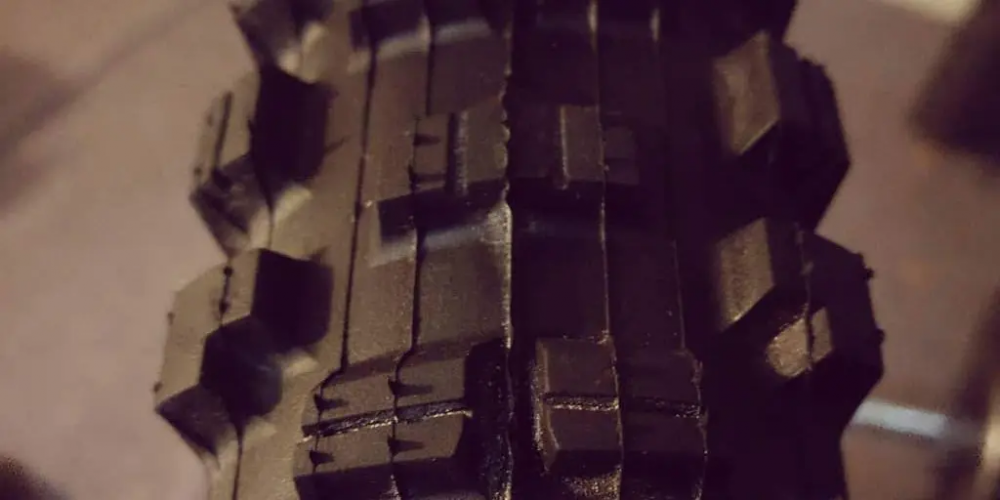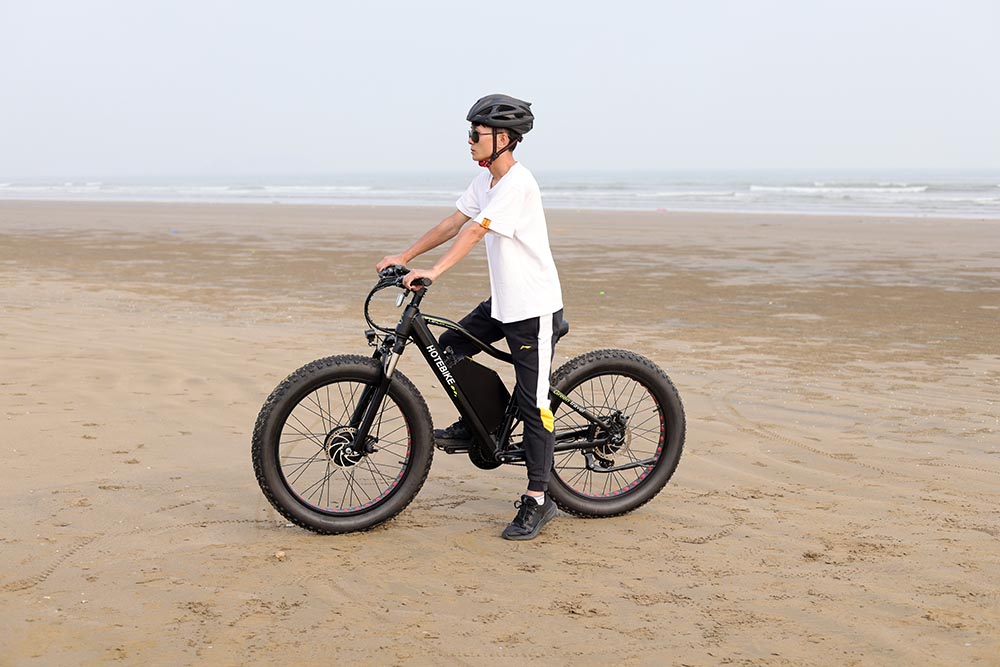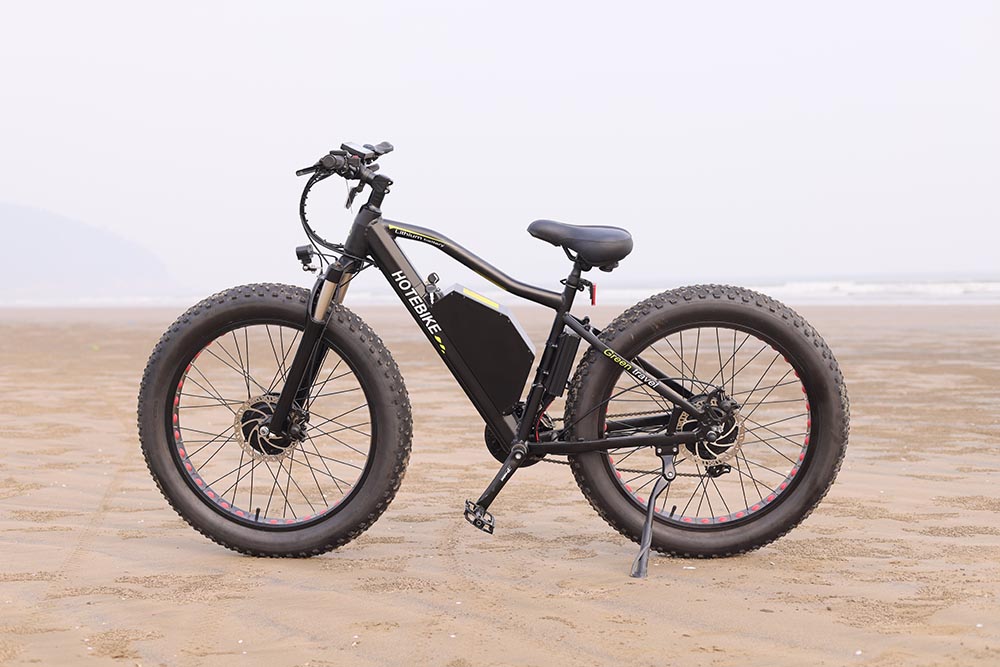Why do mountain bikes have fat tires?

Mountain bikes tires are often much thicker than other types of bikes for several reasons. Foremost among them is that wider tires running at lower pressures have a much larger contact area with the ground, allowing the aggressive tread pattern to provide excellent grip on all types of uneven terrain. But that’s just one of the benefits.
Another benefit is that wider tires (usually running on wider rims) contain a greater amount of air. Since it operates at lower pressures, typically around 22-28psi, it provides some level of damping to damp harsh chatter and shock on rough surfaces – such as when riding fast on rocky terrain. While front (and usually rear) suspension is standard on modern mountain bikes, the amount of air in the tires of course also contributes to the overall feel of the mountain bike.
So why are there different mountain bike tire widths?
Different types of mountain bikes are often equipped with very different types of tires—and the widths of those tires are no exception. There’s definitely some crossover, but the typical range is off-road (XC) bikes with tire widths ranging from 1.9 to 2.25 inches, to cyclocross bikes from 2.25 inches to 2.35 inches, to burly enduro/downhill bikes from 2.4 inches to 2.6 inches.
As I mentioned, there’s definitely some blurring of the lines there – these days, trail bikes typically come with 2.4″-2.5″ tires as these bikes become more capable on rougher terrain and riders They are also constantly pushing the envelope to learn more about where they ride regularly.
While using wider tires always adds weight – often running with larger more aggressive and stickier tread patterns and taller knobs (and thicker sidewalls) this becomes even more pronounced – The extra grip provided is very noticeable when you’re riding challenging terrain. The changes also mean the tires are more likely to stay intact and ride at high speeds or on rough trails such as hills and rock gardens.

What is the optimal tire width?
As mentioned above, it depends a lot on the type of riding you’ll be doing. As I go from an entry-level XC bike through intermediate skills and terrain on flat, easy trails, and now into double black diamond downhill trails full of rocks, drops, and other technical features, I find that I have modified my current full suspension The trail bike is more of a burly enduro all-mountain spec – with cheesy 2.5-inch wide tires and a very aggressive knobby tread as it feels more confident on steep rocky descents and bike park laps, and all that Extra clench. Of course it does make the bike feel a little slower and less snappy on flat ground when pedaling, but for me the tradeoff is a good one as the adrenaline drop and technical challenge is what I love most about the sport place.
Off-road mountain bike racers, on the other hand, will want narrower tires, thinner sidewalls, a low-profile tread pattern, and generally less sticky tire compounds to give them less rolling resistance and Allow faster acceleration, for example, pedaling and climbing, and use a higher power-to-weight ratio to increase their chances of a podium finish.
Can I fit wider tires on my mountain bike?
In general, it’s definitely possible to get wider tires, but how much wider depends on several factors. If your mountain bike type is designed with tires that are much narrower than you want, you may have tire clearance issues – especially in the rear, where the thicker tire tread will end up rubbing against the bike’s frame rather than the design For such a wide tread – although it’s not as serious as it used to be. Even if it looks just right, keep in mind that when the wheels and tires flex and deform under high-speed cornering/braking, this can cause tire friction and in worst case damage to your carbon fiber frame or wheel ties Certainly.
Bicycle manufacturers often publish the maximum tire size that a particular model’s frame design will fit—and so do suspension fork manufacturers—so if you think you might be pushing your limits, it’s a good idea to check.
So what is the best? Fat tires or skinny tires?
It all depends on the type of trail/terrain and mountain bike you ride and what suits your needs best.
Downhill bike riders always want their tires to be completely different than off-road racers
XC racers may value the low rolling resistance and lighter tires of narrower tires if downhillers want extremely sticky wide and rugged tires that provide excellent grip at high speeds during often short, hard descents. Its tread is just enough to keep their rubber side down without slowing them down on hills and big pedal power distances. Off-road riders are usually somewhere in between, wanting reliable grip from reasonably wide tires, riding uphill, and enjoying the technical challenge and descending speed as much as possible.
For me, without a doubt, I like wider tires on wider rims on dirt bikes. Usually 2.5″ tires on 30mm rims. It’s important to understand that this isn’t actually the widest on a modern mountain bike, but I (and many other riders) have found it has changed the feel of the bike, providing a ton of confidence on the trail, which I’d love Accept weight penalties. The best front tire I’ve ever used is a Maxxis Minion 2.5″ DHF WT Maxxgrip, while the rear Maxxis Minion 2.4″ DHR WT DoubleDown is my go-to tire.
While I did notice the wide sticky tires would slow me down a bit on long rides on flat terrain, that’s a price I’d be more than happy to pay – on very challenging downhill trails Bike park bump laps, or big hill downhills are where I get the most pleasure out of my bike – and importantly, that doesn’t stop me from doing epic quests all day in the mountains, including huge climbs and descents Altitude change.

What are “Wide Trail” tires for?
Essentially, Maxxis or similar names for other brands simply mean that the tires are profiled for use on rims with an internal width of 30mm to 35mm.
This is because prior to this, most mountain bike tires were designed to run on 21-23mm rims. Placing a tire designed for a narrower rim on a 30-35mm rim will result in a tire with a significantly different profile than it would be on a wider rim. It can also cause the tire to roll more on the rim during high-speed cornering.
Wide Trail (or WT) tires solve this problem by having a wider upper tread carcass and pattern, so the correct tread profile between the middle and side knobs for cornering grip – and with wider Improved cornering stability when rims are paired – reduces the amount of tire folds during fast cornering.
What are the fattest tires available for a bike?
Generally speaking, around 2.5″-2.6″ is considered the widest tire on a modern 27.5″ and 29″ wheel size bike, but there are also many bikes that are designed with larger tires in mind – usually up to 2.8″ – 3.0″ wide and offer more air volume, cushioning and ground contact area (at the cost of weight, obviously). Some riders do like them and the Plus tires have been retrofitted to a ton of different bike makes and models.
In addition to that, we also entered the Fat Bike space. Often considered their own specific type of mountain bike, fat bikes arose out of a desire to ride local terrain on previously unridable surfaces such as snow and sand. To solve the problem of narrower stock mountain bike tires sinking into sand or snow and jamming the rider almost immediately, thicker tires, usually hardtails, were added to allow the tires to run at extremely low pressures and cause In a high degree of ductility and a very large contact surface with the ground surface. This allows the bike to continue rolling on sand and snow, albeit at generally lower speeds, but solves that problem – and allows the bike to now be ridden in almost every conceivable location on Earth.
Typically, fat bikes use 3.8-inch to 4.8-inch tires, on 55mm+ rims, as low as 8 psi.
Why use different width tires on the front and rear of the bike?
So, as we’ve covered, wider mountain bike tires can often provide more grip, but at the expense of pedal-driven speeds that require more weight and more power on flats or uphill.
A popular way to get the best of both worlds is to use wider tires like a 2.5-inch Wide Trail DHF up front, and maybe a 2.35-inch Aggressor in the rear. This results in maximum front grip, with a more aggressive sticky tread and a wider contact patch, which is arguably the most important, and a faster rolling, lower profile tread pattern with a rear-to-ground contact The contact surface is smaller.
If you are looking for a new way of commuting or want a healthier lifestyle, we are here to help you. Visit our website to learn more about electric bikes and electric scooter or please leave information to us.
Error: Contact form not found.
 Shuangye ebike
Shuangye ebike
